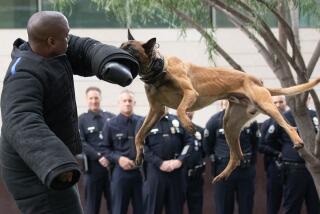The Despot Depot
- Share via
Marc Cashman was browsing in a Louisville, Ky., antique store in 1985 when he spotted a solid brass ashtray of a boy urinating on a swastika, a takeoff on Mannekin Pis, the famed Belgian fountain. The ashtray was made after the Allies pushed German forces out of Brussels in World War II. Cashman bought it in remembrance of distant relatives lost in the Holocaust. “I had never seen anti-Nazi memorabilia or material that would denigrate or mock the image or memory of Hitler, so I bought it.”
Nearly 20 years later, Cashman’s massive “anti-dictator” collection includes material relating to figures such as Mussolini, Gen. Hideki Tojo, the Ayatollah Ruhollah Khomeini and Osama bin Laden. But the core is perhaps his 60 stand-alone anti-Hitler objects worth, in his estimation, at least $30,000. For instance, a Hitler-headed piggy bank that squeals when a coin is inserted is worth $300, he says. Among his favorite items are two pincushions for needling Hitler’s derriere. The collection includes a fake PEZ dispenser with Der Fuhrer’s head and a matchbook advertising war bonds with instructions to “strike on backside” of Hitler. That’s not counting 150 original print ads from magazines, including one from Texaco that asks, “Mommy, who was Hitler?” and another from Interwoven Socks showing Santa Claus strangling Hitler while stepping on Mussolini and Tojo.
Two U.S. wars with Iraq in a 12-year span have increased Cashman’s cache, with the collection ballooning since March, the start of the second conflict. Cashman’s Santa Clarita home contains numerous boxes of statues, key chains, figurines, voodoo dolls, a bobble-headed Saddam Hussein with a beret stenciled “I love France,” even Hussein toilet paper with wordplays on “Shiite.”
The Internet has made collecting easier. “I’ve won so many auctions I can’t imagine anyone has more,” says Cashman, 54. “The Internet is extraordinary because of the ability to contact people all over the world. I don’t have to go to any more military shows.” That’s a relief to Cashman, who grew tired of explaining the meaning of the prefix “anti” at military collectible events.
He doesn’t display the assemblage, which is stored in his home office amid the trophies and plaques, including Clio awards, he’s won as a radio advertising producer. “The only people who I show it to are my close friends,” he says. “People don’t understand it.”
Cashman’s arguably more tasteful collection of American advertising dolls and icons, such as the original Mr. Peanut of Planters peanuts and Speedy Alka-Seltzer, has been relegated to a cabinet as the dictator material fills drawers, boxes and closets. “My wife’s going to kill me,” he says, placing a Scud missile-shaped fishing lure next to a stained-glass nightlight of an American eagle making a familiar finger gesture to tyrants everywhere. “She thinks I’m nuts.”
Indeed, Lola Rodriguez Cashman is not a huge fan of her husband’s anti-dictator objets. “It’s interesting from a historical point of view,” she says, rolling her eyes. “I just hate looking at it. I don’t find them amusing. You realize I could have a Monet by now?”
Cashman has his limits. “I won’t buy actual artifacts. Nothing seized from the wars. Or the anti-Saddam T-shirts.” But he doesn’t turn down dartboards, and owns several of Saddam and one of Hitler made in England during WWII.
He admits some of the pieces are morbid, including the terrorist body bag that comes with detailed directions. But he sees himself as an amateur curator of museum-worthy artifacts. “This is how we deal with war and its sociological propaganda,” he says. “It’s not a hate collection. This is how we personify our enemies. We mock them mercilessly.”


